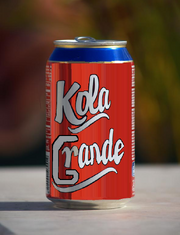SouthWriter (talk | contribs) No edit summary |
SpanishSpy (talk | contribs) (Adding categories) |
||
| Line 38: | Line 38: | ||
[[Category:Corporations (1983: Doomsday)]] |
[[Category:Corporations (1983: Doomsday)]] |
||
[[Category:Economy (1983: Doomsday)]] |
[[Category:Economy (1983: Doomsday)]] |
||
| + | [[Category:Food]] |
||
Revision as of 03:02, 16 May 2012

Kola Grande is a carbonated soft drink produced in Cuba sold in stores, restaurants, and vending machines in the Caribbean and since recently in a variety of countries in Asia.
History
The production of Kola Grande started in 2008, after a Cuban scouting party discovered the formula for Coca-Cola in the ruins of Atlanta in 2007. Together with the USSR, Cuba has worked to reintroduce the drink under a new brand, focusing on the supposed "revolutionary" nature of the drink, in order to compete with its competitors.
Originally, the product was produced by the Cerveceria Bucanero company but the Cuban government wanted to focus more on the product and decided to create a separate company, called Kola Grande Inc. in 2009. The reach of the state-run company has expanded greatly since then.
The product has shown great promise over the past three years, being introduced to most of the Caribbean markets fairly early on. Small quantities of the drink were also transported to the USSR as well as the People's Republic of Angola from 2009 to 2011, with both countries opting to give Cuba a monopoly on the soft drink distribution in both countries, which made the products production soar in that time. An agreement with Siberia in 2010 also gave rights to Cuba to create a factory on Siberian territory in Sovetskaya Gavan, with the factory being completed in December of 2011. Currently, the factory caters mostly to Siberia's demand for the drink, while it is also starting to distribute it to Korea, Aralia, Tibet and Japan as well.
The Cuban government is also trying to open up factories in these countries as well, to expand the distribution of the drink.
Production & ingredients
Ingredients
- carbonated water
- sugar (produced from local sugarcane)
- caffeine
- phosphoric acid
- caramel color
- natural flavorings (the content of which is secret)
Franchised production model
The Cuban producers of the drink have opted to use a franchised production model as of late, with the factory in Siberia buying the syrup concentrate from Cuba which they then mix with filtered water and sweeteners, and then carbonate it before putting it in cans and bottles.
Formula of the natural flavorings
Cuban authorities have, like Coca-Cola before them, kept the secret of the natural flavorings used in the drink. It is said that Tomás Diez Acosta, the leader of Cuba himself, keeps the formula in his home in Nueva Gerona, with it being guarded around the clock.
Factory locations
The main factory is located in Holguín and is located next to another Cuban company, Cerveceria Bucanero, the original parent company. Bottling factories have already been established in these Caribbean countries:
- Dominican Republic
- Guatemala
- Nicaragua
A factory in Costa Rica is also being built, the planned date of completion being in May 2012. The company has also set up a factory in the USSR, the first of many to come in Asia.
Use as a political symbol
The Cubans aggressively promote the drink as an alternative to all other "corporate" products of the ANZC and SAC. Kola Grande is advertised as "anti-imperialist and revolutionary", and their slogan is: Revolutionize your drink- Kola Grande, the thirst quencher (Spanish: Revolucionar su bebida -- Kola-Grande, el extintor de la sed.).
